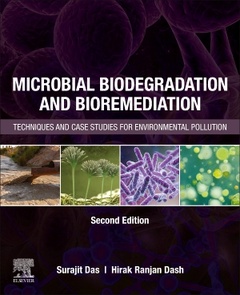Description
Microbial Biodegradation and Bioremediation (2nd Ed.)
Techniques and Case Studies for Environmental Pollution
Coordinators: Das Surajit, Dash Hirak Ranjan
Language: English
Subjects for Microbial Biodegradation and Bioremediation:
Keywords
?Actinobacteria; Adsorption; Aquaculture; Aromatic pollutants; Azo dye; BES; Bacteria; Bioaccumulation; Bioanodic oxidation; Biocathodic reduction; Biodegradation; Bioelectrochemical; Bioelectrochemical oxidation; Bioelectrochemical reduction; Bioelectrochemical system; Biofilm; Biofilms; Biogeochemistry; Bioorganic/inorganic pollutants; Bioremediation; Bioremediation strategies; Biosensors; Biosorption; Biosurfactants; Biotechnological applications; Carbon capture; Case study; Competitive adsorption; Conservation; Contaminant; Contaminants; Contaminated sites; Coral; Culture-independent approach; Cyanobacteria; Cyanobacterial remediation; Domestic wastewater; Donnan; E-Redox; Electric potential correction; Electrochemistry; Electrogenic microbes; Enterobacter cloacae; Environment; Environmental exposure; Environmental pollution; Enzymes; Eutrophication; Exopolymeric substances; Extracellular electron transfer; Extreme environment; FTIR; Fungi; Genetic manipulation; Health effects; Health hazards; Heavy metals; Heavy metals pollution; Human health; Hydrocarbon-degrading bacteria; Hydrophobic organic compounds; Ideal adsorbed solution theory (IAST); Industrial effluents; Industrial wastewater; Inorganic pollutant; Isotherm; Laccase; Lignin peroxidase; MFC; Manganese peroxidase; Marine environment; Marine oil spills; Metabolic pathways; Metagenomics; Metal detoxification; Metals; Microalgae; Microbial bioremediation; Microbial communities; Microbial diversity; Microbial electrochemical technologies (MET); Microbial enhanced oil recovery; Microbial fuel cell; Microbiota; Microorganism; Microorganisms; Microplastics; Microprecipitation; Mitigation; Molecular tools; Monitoring; Nanoremediation; Nanotoxicity; Next-generation sequencing; Next-generation sequencing technology; Ocean; Oil pollution; Omics approach; Opd gene; Organic pollutant
646 p. · 19x23.4 cm · Paperback
Description
/li>Contents
/li>Biography
/li>Comment
/li>
Microbial Biodegradation and Bioremediation: Techniques and Case Studies for Environmental Pollution, Second Edition describes the successful application of microbes and their derivatives for bioremediation of potentially toxic and relatively novel compounds in the environment. Our natural biodiversity and environment is in danger due to the release of continuously emerging potential pollutants by anthropogenic activities. Though many attempts have been made to eradicate and remediate these noxious elements, thousands of xenobiotics of relatively new entities emerge every day, thus worsening the situation. Primitive microorganisms are highly adaptable to toxic environments, and can reduce the load of toxic elements by their successful transformation and remediation.
This completely updated new edition presents many new technologies and techniques and includes theoretical context and case studies in every chapter. Microbial Biodegradation and Bioremediation: Techniques and Case Studies for Environmental Pollution, Second Edition serves as a single-source reference and encompasses all categories of pollutants and their applications in a convenient, comprehensive format for researchers in environmental science and engineering, pollution, environmental microbiology, and biotechnology.
1. Microbial bioremediation: A potential tool for restoration of the contaminated areas 2. Heavy metals and hydrocarbons: Adverse effects and mechanism of toxicity 3. Nanotoxicity: Aspects and concerns in biological systems 4. Application of molecular techniques for assessment of microbial communities in contaminated sites 5. Microbial indicators for monitoring pollution and bioremediation 6. Biofilm mediated bioremediation of PAHs 7. Nano-particle based bioremediation 8. Bioremediation using extremophiles 9. Role of Actinobacteria in bioremediation 10. Biology, genetic aspects and oxidative stress response of Streptomyces and strategies for bioremediation of toxic metals 11. Fungal bioremediation strategies 12. Microbial bioremediation of industrial effluents 13. Bioremediation of polythene wastes 14. Phycoremediation of contaminated water and soil coupled with generation of value added products 15. Feasibility of using microbial fuel cell technology for bioremediation 16. Microbial bioremediation: A metagenomic approach 17. In-silico approach in bioremediation 18. Microbial bioremediation of greenhouse gases 19. Enzymes/Enzymatic reactions in bioremediation 20. Microbiological metabolism under chemical stress 21. Bioremediation of pesticides: A case study 22. Microalgae in removal of heavy metal and organic pollutants from soil 23. Bioremediation of aquaculture effluents 24. Aquifer microbiology of different geogenic setting for environmental biogeotechnology 25. Exploring prospects of mono-oxygenases based bio-catalyst in xenobiotics and their computational modelling 26. White-rot fungi and their Environmental applications 27. Remediation of environmental pollution by genetically engineered Bacteria 28. Toxicity on human-health and adverse consequences of cosmetics 29. Bioremediation of Steroidal Estrogens 30. Increased coverage of nanoremediation/ Applications and implications of nanotechnology in remediation of environmental pollutants 31. Bioremediation of Heavy Metals/ New insights into bioremediation of toxic metals 32. Expanded coverage of effluents from various industries 33. New Techniques for contaminant transport/ monitoring of contaminant transport 34. In situ and ex situ methods of bioremediation 35. Factors affecting bioremediation 36. Non-molecular methods of monitoring bioremediation
Prof. Surajit Das iscurrently working at the Department of Life Science, National Institute of Technology Rourkela, India. He received his doctoral degree in Marine Biology with specialization in microbiology from the Centre of Advanced Study in Marine Biology, Annamalai University, Tamil Nadu, India. He has been awarded the Endeavour Research Fellowship by the Australian Government to conduct postdoctoral research on marine microbial technology at the University of Tasmania. He has more than 15 years of research experience in environmental biotechnology, marine microbiology, bacterial biofilm, waste water treatment, and bioremediation. Prof. Das has maintained a strong commitment to explore the diversity of marine microorganisms from tropical, coastal, mangrove, and deep-sea environments using taxonomic and molecular tools. The main goal of his research is to understand the genetic regulation of bacterial biofilm for the improvement and development of biofilm-mediated bioremediation, thereby restoring the deteriorating environment as an eco-friendly approach.
Hirak Ranjan Dash is a Researcher for the Forensic Science Laboratory at India’s National Institute of Technology. His expertise is in the field of environmental and forensic microbiology, DNA fingerprinting, microbial phylogeny and diversity, genetics, bioremediation, degradation of biological materials and applied microbiology. He has authored many publications, including articles, book chapters, and books.
- Describes many novel approaches of microbial bioremediation including genetic engineering, metagenomics, microbial fuel cell technology, biosurfactants and biofilm-based bioremediation
- Introduces relatively new hazardous elements and their bioremediation practices including oil spills, military waste water, greenhouse gases, polythene wastes, and more
- Provides the most advanced techniques in the field of bioremediation, including insilico approach, microbes as pollution indicators, use of bioreactors, techniques of pollution monitoring, and more
- Completely updated and expanded to include topics and techniques such as genetically engineered bacteria, environmental health, nanoremediation, heavy metals, contaminant transport, and in situ and ex situ methods
- Includes theoretical context and case studies within each chapter




